
Pastry is baked food made with a dough of flour, water, and shortening that may be savoury or sweetened. Sweetened pastries are often described as bakers' confectionery. The word "pastries" suggests many kinds of baked products made from ingredients such as flour, sugar, milk, butter, shortening, baking powder, and eggs. Small tarts and other sweet baked products are called pastries as a synecdoche. Common pastry dishes include pies, tarts, quiches, croissants, and pasties.

A scone is a traditional British baked good, popular in the United Kingdom and Ireland. It is usually made of either wheat flour or oatmeal with baking powder as a leavening agent, and baked on sheet pans. A scone is often slightly sweetened and occasionally glazed with egg wash. The scone is a basic component of the cream tea. It differs from teacakes and other types of sweets that are made with yeast. Scones were chosen as the Republic of Ireland representative for Café Europe during the Austrian presidency of the European Union in 2006, while the United Kingdom chose shortbread.
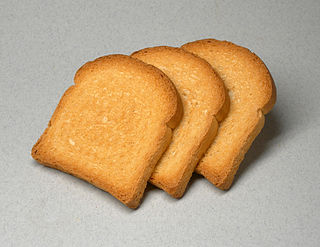
Zwieback is a form of rusk eaten in Austria, Belgium, Bosnia-Herzegovina, Bulgaria, Croatia, France, Germany, Greece, Italy, Luxembourg, The Netherlands, North Macedonia, Poland, Scandinavia, Serbia, Slovenia, Switzerland and Turkey. It is a type of crisp, sweetened bread, made with eggs and baked twice. It originated in East Prussia. According to Fabian Scheidler, Albrecht von Wallenstein invented zwieback to feed his mercenary army during the Thirty Years' War. The Mennonites brought Zwieback to the Russian Empire; before the Russian Revolution, when many emigrated to the west, they brought Zwieback to Canada, the United States and other parts of the world.

Roti is a round flatbread native to the Indian subcontinent. It is commonly consumed in many South Asian countries.

Pierogi are filled dumplings, made by wrapping unleavened dough around a filling, and occasionally flavored with a savory or sweet garnish and cooking in boiling water.

A rusk is a hard, dry biscuit or a twice-baked bread. It is sometimes used as a teether for babies. In some cultures, rusk is made of cake, rather than bread: this is sometimes referred to as cake rusk. In the UK, the name also refers to a wheat-based food additive.

Challah is a special bread of Ashkenazi Jewish origin, usually braided and typically eaten on ceremonial occasions such as Shabbat and major Jewish holidays. Ritually acceptable challah is made of dough from which a small portion has been set aside as an offering. Challah may also refer to the dough offering. The word is biblical in origin, meaning "loaf". Similar braided breads such as kalach and vánočka are found across Central and Eastern Europe.

The ensaïmada is a pastry product from Mallorca, Balearic Islands, Spain. It is a common cuisine eaten in southwestern Europe, Latin America and the Philippines.
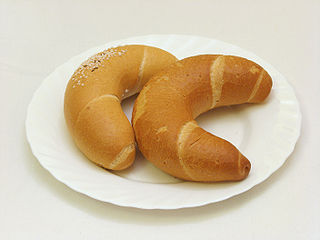
Kifli, kiflice, kifle, or kipferl is a traditional yeast bread roll that is rolled and formed into a crescent before baking.
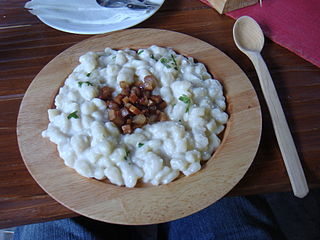
Slovak cuisine varies slightly from region to region across Slovakia. It was influenced by the traditional cuisine of its neighbours and it influenced them as well. The origins of traditional Slovak cuisine can be traced to times when the majority of the population lived self-sufficiently in villages, with very limited food imports and exports and with no modern means of food preservation or processing.

Paska is a sweet decorative bread native to Ukraine. It is a variation of Easter bread, a tradition particularly spread in countries with predominant Eastern Orthodox religious or cultural connections to the ancient Byzantine Empire. Paska breads are a traditional element in the Easter holidays of Ukraine, Armenia, Belarus, Romania, Russia, Georgia, Moldova and parts of Bulgaria, as well as Turkey, Iran and the Assyrian-Chaldean-Syriac diaspora. Due to its geographical closeness, it is also widespread in Slovakia. Meanwhile, it is also eaten in countries with immigrant populations in Eastern Europe such as the United States, Canada and the United Kingdom.

Tatar cuisine is primarily the cuisine of the Volga Tatars, who live in Tatarstan, Russia, and surrounding areas.
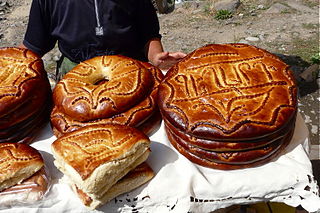
Gata is an Armenian pastry or sweet bread. There are many variations of gata in Armenia. Typically, specific towns or regions will have their own version. It can be found in a variety of shapes, sizes and may be decorated or left unadorned. Long ago, gata was baked in a tonir, but it is now baked in ovens. The bread is traditionally eaten at the feast of Candlemas, but is eaten during other festivities too or simply baked to enjoy with a cup of tea or coffee.

The poppy seed roll is a pastry consisting of a roll of sweet yeast bread with a dense, rich, bittersweet filling of poppy seed. An alternative filling is a paste of minced walnuts, or minced chestnuts.
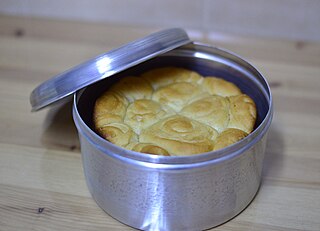
Kubaneh is a traditional Yemenite Jewish bread that is popular in Israel. Kubaneh is traditionally baked overnight to be served for Shabbat morning accompanied by haminados, and resek agvaniyot.

Dumpling is a broad class of dishes that consist of pieces of cooked dough, often wrapped around a filling. The dough can be based on bread, wheat or other flours, or potatoes, and it may be filled with meat, fish, tofu, cheese, vegetables, or a combination. Dumplings may be prepared using a variety of cooking methods and are found in many world cuisines.

Mennonite cuisine is food that is unique to and/or commonly associated with Mennonites, a Christian denomination that came out of sixteenth-century Protestant Reformation in Switzerland and the Netherlands. Because of persecution, they lived in community and fled to Prussia, Russia, North America, and Latin America. Groups like the Russian Mennonites developed a sense of ethnicity, which included cuisine adapted from the countries where they lived; thus, the term "Mennonite cuisine" does not apply to all, or even most Mennonites today, especially those outside of the traditional ethnic Mennonite groups. Nor is the food necessarily unique to Mennonites, most of the dishes being variations on recipes common to the countries where they reside or resided in the past.
















